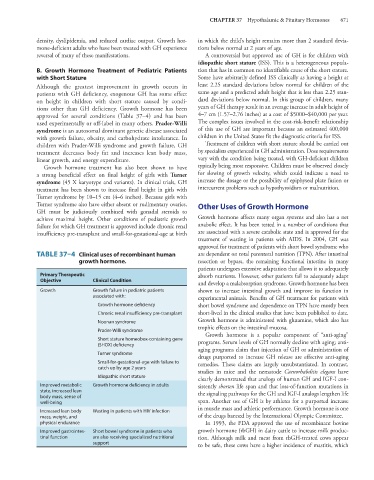Page 685 - Basic _ Clinical Pharmacology ( PDFDrive )
P. 685
CHAPTER 37 Hypothalamic & Pituitary Hormones 671
density, dyslipidemia, and reduced cardiac output. Growth hor- in which the child’s height remains more than 2 standard devia-
mone-deficient adults who have been treated with GH experience tions below normal at 2 years of age.
reversal of many of these manifestations. A controversial but approved use of GH is for children with
idiopathic short stature (ISS). This is a heterogeneous popula-
B. Growth Hormone Treatment of Pediatric Patients tion that has in common no identifiable cause of the short stature.
with Short Stature Some have arbitrarily defined ISS clinically as having a height at
Although the greatest improvement in growth occurs in least 2.25 standard deviations below normal for children of the
patients with GH deficiency, exogenous GH has some effect same age and a predicted adult height that is less than 2.25 stan-
on height in children with short stature caused by condi- dard deviations below normal. In this group of children, many
tions other than GH deficiency. Growth hormone has been years of GH therapy result in an average increase in adult height of
approved for several conditions (Table 37–4) and has been 4–7 cm (1.57–2.76 inches) at a cost of $5000–$40,000 per year.
used experimentally or off-label in many others. Prader-Willi The complex issues involved in the cost-risk-benefit relationship
syndrome is an autosomal dominant genetic disease associated of this use of GH are important because an estimated 400,000
with growth failure, obesity, and carbohydrate intolerance. In children in the United States fit the diagnostic criteria for ISS.
children with Prader-Willi syndrome and growth failure, GH Treatment of children with short stature should be carried out
treatment decreases body fat and increases lean body mass, by specialists experienced in GH administration. Dose requirements
linear growth, and energy expenditure. vary with the condition being treated, with GH-deficient children
Growth hormone treatment has also been shown to have typically being most responsive. Children must be observed closely
a strong beneficial effect on final height of girls with Turner for slowing of growth velocity, which could indicate a need to
syndrome (45 X karyotype and variants). In clinical trials, GH increase the dosage or the possibility of epiphyseal plate fusion or
treatment has been shown to increase final height in girls with intercurrent problems such as hypothyroidism or malnutrition.
Turner syndrome by 10–15 cm (4–6 inches). Because girls with
Turner syndrome also have either absent or rudimentary ovaries, Other Uses of Growth Hormone
GH must be judiciously combined with gonadal steroids to
achieve maximal height. Other conditions of pediatric growth Growth hormone affects many organ systems and also has a net
failure for which GH treatment is approved include chronic renal anabolic effect. It has been tested in a number of conditions that
insufficiency pre-transplant and small-for-gestational-age at birth are associated with a severe catabolic state and is approved for the
treatment of wasting in patients with AIDS. In 2004, GH was
approved for treatment of patients with short bowel syndrome who
TABLE 37–4 Clinical uses of recombinant human are dependent on total parenteral nutrition (TPN). After intestinal
growth hormone. resection or bypass, the remaining functional intestine in many
patients undergoes extensive adaptation that allows it to adequately
Primary Therapeutic absorb nutrients. However, other patients fail to adequately adapt
Objective Clinical Condition
and develop a malabsorption syndrome. Growth hormone has been
Growth Growth failure in pediatric patients shown to increase intestinal growth and improve its function in
associated with: experimental animals. Benefits of GH treatment for patients with
Growth hormone deficiency short bowel syndrome and dependence on TPN have mostly been
Chronic renal insufficiency pre-transplant short-lived in the clinical studies that have been published to date.
Noonan syndrome Growth hormone is administered with glutamine, which also has
trophic effects on the intestinal mucosa.
Prader-Willi syndrome
Growth hormone is a popular component of “anti-aging”
Short stature homeobox-containing gene programs. Serum levels of GH normally decline with aging; anti-
(SHOX) deficiency
aging programs claim that injection of GH or administration of
Turner syndrome
drugs purported to increase GH release are effective anti-aging
Small-for-gestational-age with failure to remedies. These claims are largely unsubstantiated. In contrast,
catch up by age 2 years
studies in mice and the nematode Caenorhabditis elegans have
Idiopathic short stature
clearly demonstrated that analogs of human GH and IGF-I con-
Improved metabolic Growth hormone deficiency in adults sistently shorten life span and that loss-of-function mutations in
state, increased lean the signaling pathways for the GH and IGF-I analogs lengthen life
body mass, sense of
well-being span. Another use of GH is by athletes for a purported increase
in muscle mass and athletic performance. Growth hormone is one
Increased lean body Wasting in patients with HIV infection
mass, weight, and of the drugs banned by the International Olympic Committee.
physical endurance In 1993, the FDA approved the use of recombinant bovine
Improved gastrointes- Short bowel syndrome in patients who growth hormone (rbGH) in dairy cattle to increase milk produc-
tinal function are also receiving specialized nutritional tion. Although milk and meat from rbGH-treated cows appear
support to be safe, these cows have a higher incidence of mastitis, which

